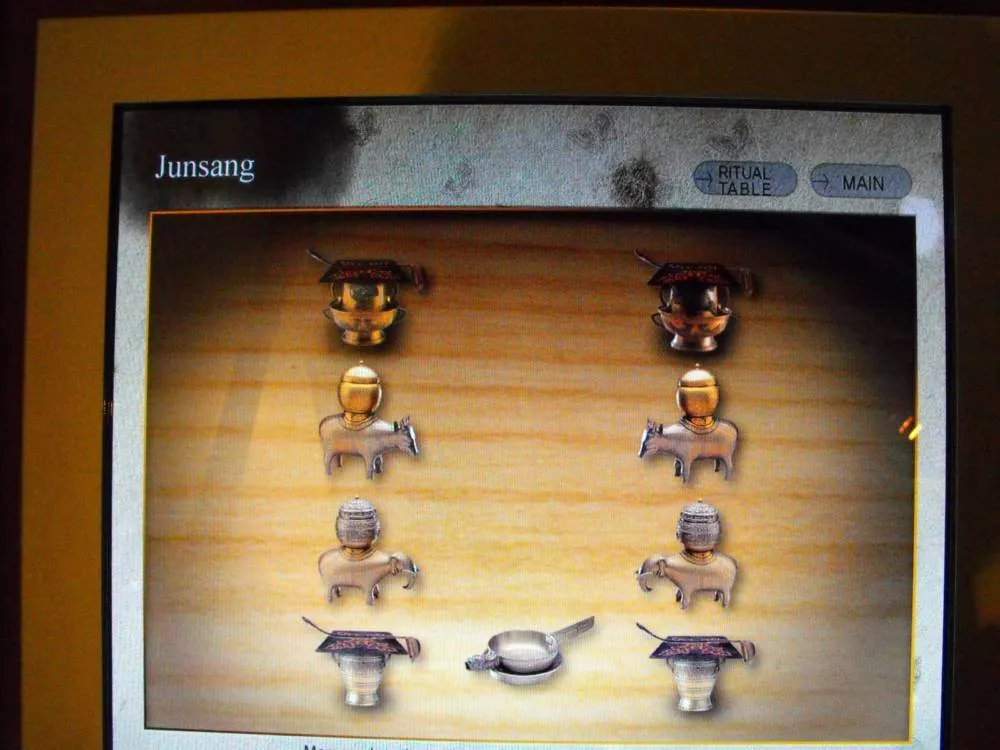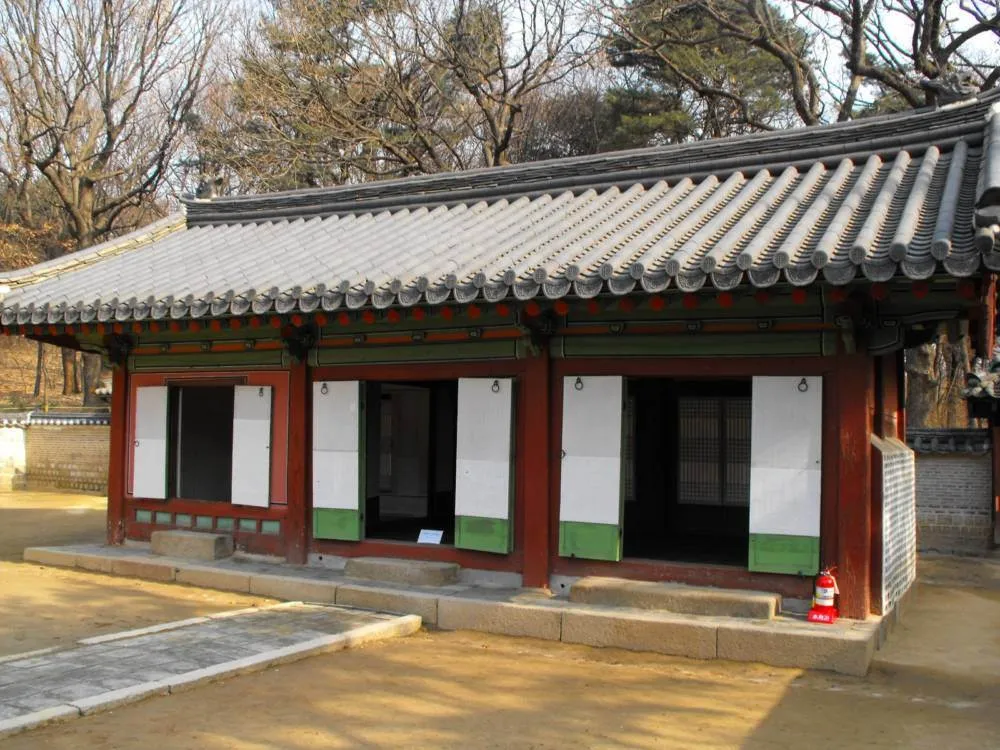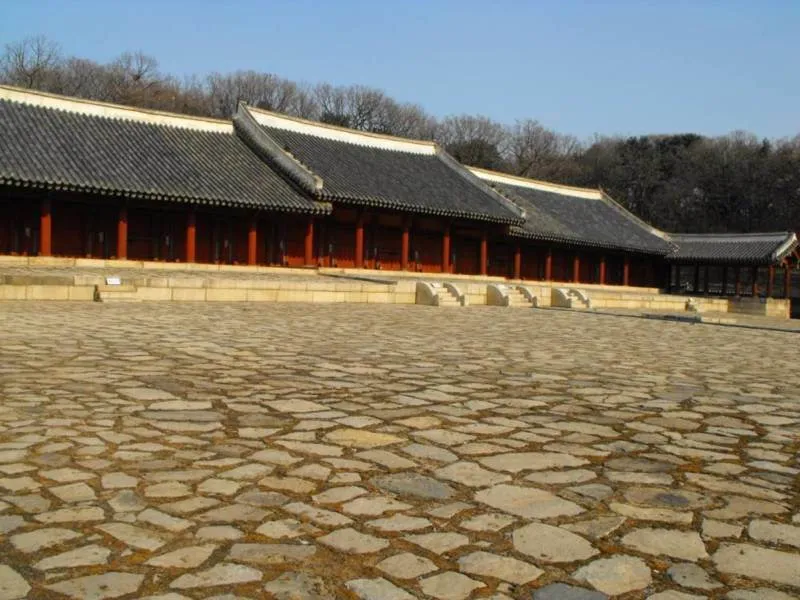Jongmyo is more than your average royal shrine (not that there are many of those around to begin with). This place serves as the royal shrine for the Joseon Dynasty, which lasted from 1392-1910. Here their spirits are kept for any number of auspicious reasons, and once a year (the first Sunday in May) a ceremony of ritual food and drink is offered to them hoping for their blessing.

Coming from the subway station, one first must navigate the biggest group of ajosshis I’d seen in a long time. What’s going on – a 50th high school reunion?


Nope – baduk (Go) and janggi (Korean chess) are the preferred games played in this local park. While there didn’t seem to be an organized group, they didn’t look like they needed one.

Some local art – staircases of some kind?

A statue of Lee Sang-Jae (also known by his pen name, Wolnam). He died as a martyr against Japanese imperial forces in 1927, and served with the YMCA, Sonyeon Cheokhudan (the Boy Scout Federation), and a number of other movements.

A little history lesson takes us back to 1395: Yi-Seong-gye, also known as King Taejo, chose Seoul as his new capital to begin what we call the Joseon Dynasty today. The original shrine (Jeongjeon, or the Main Hall) took about nine months to build, and was expanded and repaired to accomodate the spirit tablets of more kings and queens. In 1421, a second shrine (Yeongnyeongjeon, or the Hall of Everlasting Peace) was built to handle even more spirit tablets, and was expanded again in 1546. In 1592, the structures were burnt by the Hideyoshi invasion, but were rebuilt in 1608, and expanded three more times in 1667, 1726, and 1836. And you thought your family tree went back far… Today, Jeongjeon, the main hall, honors 49 different people with spirit tablets, while Yeongnyeongjeon, the second shrine, holds 34 more spirit tablets.

Korea is the only Confucian state / country to have preserved its royal shrine and continues to conduct royal ancestral rites, a fact that UNESCO recognized as a World Heritage in 1995. The ceremony itself, Jongmyo Jerye, was considered a Masterpiece of the Oral and Intangible Heritage of Humanity in 2001. In other words, it’s not just distinctive to Korean history, but also to world history as well.

The pond, frozen over – this is the winter after all.


A small shrine honoring King Gongmin, a monarch from the Goryeo dynasty (the dynasty before the Joseon dynasty). While the exact reason is not known, the sign describes him as restoring “the sovereignty and territory of Goryeo by defeating Yuan China and implemented sweeping reforms.”
The next building you’ll see is part of the reason UNESCO gave their blessing to the shrine:

The Incense Pathway – a brick-tiled path to reach the building. Think of the brick tiles as the red carpet for the kings and ceremonial people of the day.

Inside part of the exhibit. A few standard posters, along with a video loop displaying some of the ceremony.


The many ceremonial dishes used during the Jongmyo Jerye. Each dish has a specific purpose, which requires a nearby touch-screen guide to navigate:

The touch-screen for the Junsang – nine dishes holding various alcoholic beverages or other liquids. The foods used included cooked and uncooked meat along with fruit, all used to memorialize the customs or ways of life from ancient times.

Part of the Jaegung area – where the king and crown prince would purify their minds and bodies before conducting the ceremonies.

Not a lot to see on the inside…

The gate to Jeongjeon – the main hall of spirit tablets.


Remember all those spirit tablets from earlier? This is the main hall, one of two buildings they’re stored in… The doors are closed, and there are no windows to peek into the building. In fact, you can only climb about 4 of the 6 steps to even approach the building. The doors are opened for the annual ceremony, but kept closed the rest of the year. Trust us, though, they’re in there 🙂

These places are locked up tightly – no one disturbs the ancient spirits!

A picture from the other side.


The local well gets it’s own gate and structure around it.

A nice walking trail just inside the perimeter of the stone wall, which would lead around the shrine and connect with Changgyeonggung, a palace just across the street.

The smaller of the two shrines – also known as the Hall of Everlasting Peace – still quite large and closed like the main hall.
Overall, Jongmyo is worth the visit, easy to get to, and worth an afternoon trip. Tapgol Park is close by and similar, but smaller and with less to see. Jongmyo is tranquil, serene, and part of history. I’ll be sure to return on the first Sunday of May to see the ceremony first-hand.
Directions to Jongmyo Shrine: Take line 1 of the Seoul subway system to Jongno 3-ga, than exit 11 to street level. Walk about 200 meters, then look left for Jongmyo Citizen’s Park. Walk through the park to get to the shrine, buy a ticket (1,000 won for adults, 500 won for kids), and head inside. Jongmyo opens at 9am and closes between 4:30 and 6pm depending on the day and season, but is closed every Tuesday.



No, it’s not a high school reunion… those Ajossis are out there all the time…. They do that in a park near my school too… I wonder if they have any life outside of baduk…
Jongmyo is also nice because with that 1,000 won entrance you can get into Changgyonggung palace for free if you keep going through to the opposite side of the park.